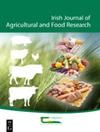爱尔兰肉牛胴体性状的遗传和表型趋势
IF 1.4
4区 农林科学
Q3 AGRICULTURE, MULTIDISCIPLINARY
引用次数: 0
摘要
遭受密集遗传选择的动物需要持续监测,以观察经济上重要性状的变化。本研究的重点是估计三种基因型:乳坝和乳公(D×D)、乳坝和牛肉公(D×B)和牛坝和牛肉公(B×B)的胴体性状的遗传和表型趋势。使用线性回归模型来生成奶牛和主要动物(即从未亲代过的动物)的胴体重、构象和脂肪评分的遗传和表型趋势。还估计了主要动物屠宰时年龄的表型趋势。结果表明,B×B组胴体质量遗传增加1.1 kg /年,D×B和D×D组分别遗传减少0.14和0.39 kg /年。表型趋势反映了D×B和B×B动物胴体重的遗传趋势,但D×D动物胴体重遗传趋势的下降并未在表型趋势中得到复制。D×D和D×B的胴体构象遗传上分别下降0.02和0.05个单位/年,B×B的胴体构象遗传上增加0.05个单位/年。构象的表型趋势与遗传趋势相似。在遗传上,D×D和B×B动物的胴体脂肪减少,但D×B动物的胴体脂肪保持不变,尽管这没有反映在表型趋势上。所有基因型的屠宰年龄均显着下降。目前的育种方案对B×B动物的胴体性状有有利的影响,但对D×D和D×B动物的胴体性状有不利的趋势。本文章由计算机程序翻译,如有差异,请以英文原文为准。
Genetic and phenotypic trends for carcass traits in Irish beef cattle
Animals subjected to intensive genetic selection require continuous monitoring to observe changes in economically important traits. The focus of this research was to estimate genetic and phenotypic trends for carcass traits for three genotypes: dairy dam and dairy sire (D×D), dairy dam and beef sire (D×B) and beef dam and beef sire (B×B). Linear regression models were used to generate genetic and phenotypic trends for carcass weight, conformation and fat score for both cows and prime animals (i.e. never parented an animal). Phenotypic trends for age at slaughter were also estimated in prime animals. Results indicated that carcass weight increased genetically by 1.1 kg per year for B×B animals, but decreased by 0.14 and 0.39 kg per year for D×B and D×D animals, respectively. Phenotypic trends reflected the genetic trends for carcass weight for D×B and B×B animals, but the decline in genetic trends for carcass weight for D×D animals was not replicated in their phenotypic trends. Carcass conformation declined genetically by 0.02 and 0.05 units per year for D×D and D×B animals, respectively, and increased by 0.05 units per year for B×B animals. Phenotypic trends for conformation were similar to genetic trends. Carcass fat showed a decrease genetically for D×D and B×B, but remained constant for D×B animals, although this was not reflected in the phenotypic trends. Age at slaughter decreased phenotypically for all genotypes. Current breeding programmes have a favourable impact on carcass traits for B×B animals, but an unfavourable trend was observed for D×D and D×B animals.
求助全文
通过发布文献求助,成功后即可免费获取论文全文。
去求助
来源期刊
CiteScore
2.50
自引率
20.00%
发文量
23
审稿时长
>36 weeks
期刊介绍:
The Irish Journal of Agricultural and Food Research is a peer reviewed open access scientific journal published by Teagasc (Agriculture and Food Development Authority, Ireland). Manuscripts on any aspect of research of direct relevance to Irish agriculture and food production, including plant and animal sciences, food science, agri environmental science, soils, engineering, buildings, economics and sociology, will be considered for publication. The work must demonstrate novelty and relevance to the field of research. Papers published or offered for publication elsewhere will not be considered, but the publication of an abstract does not preclude the publication of the full paper in this journal.

 求助内容:
求助内容: 应助结果提醒方式:
应助结果提醒方式:


